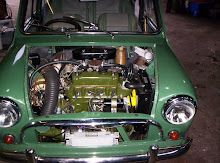When there is any risk of the temperature falling below freezing point during the winter months, it is advisable to descale and flush-out the cooling system as described on pages 46-7, and to fill-up with an anti-freezing solution, rather than relying on the doubtful precaution of draining the system overnight. If an interior heater is fitted, in fact, it is essential to use anti-freeze, as the heater element cannot be drained completely by opening the radiator and cylinder-block drain taps.
Even when an engine heater is used the cooling system must, of course, be protected when the car is parked in the open. It is also possible for the radiator to freeze when the car is first driven away after a cold start, since the thermostat will prevent circulation of water from the engine until the normal running temperature is reached.
It is essential to use an ethylene-glycol solution containing suitable inhibitors to prevent the glycol corroding the metal in the cooling system. Any of the well-known brands will be quite satisfactory in this respect. The correct amount of anti-freeze to use will be stated on the container or in a leaflet or chart obtainable from the supplier. Generally, 1£ pints will give complete protection down to approximately 17°F (15 degrees of frost), allowing for the additional pint of water in an interior heater (if fitted).
Beware of the statements issued by many suppliers that this proportion will give protection against 35 degrees of frost. While it is true that there will be no risk of a cracked block or a damaged radiator, the solution will have formed ice crystals and its "mushy" condition will prevent adequate flow through the system. When the thermometer drops to those levels the engine must be allowed to idle for at least five minutes after being started from cold, preferably with the radiator covered, to allow the system to warm up. In order to obtain complete protection at very low temperatures, in the neighbourhood of zero Fahrenheit, a mixture consisting of about equal volumes of anti-freeze and water is required—say, for convenience, 3 pints if a heater is fitted and 2\ pints without a heater. This is a point that doctors and others who may wish to drive away from cold without delay should bear in mind.
While the anti-freeze can be left in the system during the summer months, it is advisable to drain it off in the spring since the anti-corrosion inhibitors which are incorporated in the ethylene-glycol mixture tend to lose their effectiveness over a prolonged period of use: there is also the risk that during the summer the radiator may be topped-up more fre¬quently and plain water may be used if the anti-freeze solution is not readily available.
Saturday, 17 October 2009
Anti-freezing Solutions
Posted by Info Mini Cars at 03:41
Subscribe to:
Post Comments (Atom)


0 comments:
Post a Comment